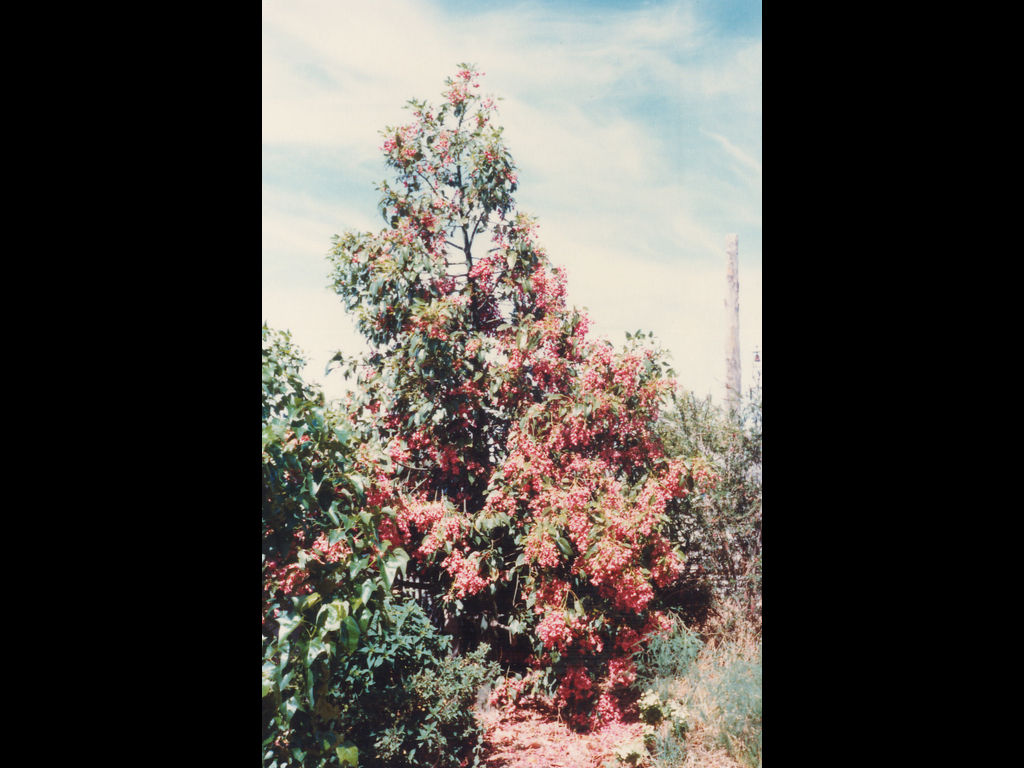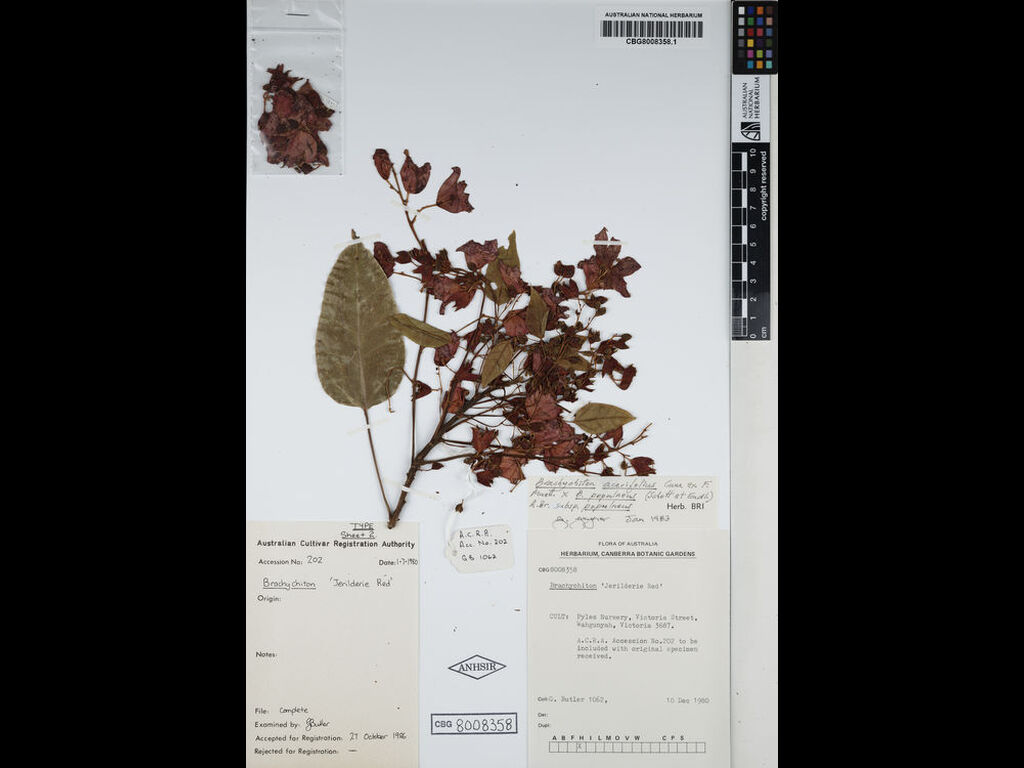Brachychiton 'Jerilderie Red'
- File Number
- 202
- ACRA Field Book Number
- -
- Registration Date
- 26/10/1986
- Application Received
- 01/07/1980
- Family
- Malvaceae
- Cultivar Name
- Brachychiton 'Jerilderie Red'
- Origin
- Brachychiton 'Jerilderie Red' is a hybrid between B. populneus and B. acerifolius. Its origin is uncertain. The application states that it arose in Jerilderie, NSW, about 1890. The cultivar was first received by the Authority July 1980. Registration applied for by Mr J W Pyle, New Era Nursery, Wahgunyah , Victoria, 3687.
- Characteristics
- This cultivar is a tree ca. 9m tall by 6.5m wide. The canopy is dense. The leaves vary somewhat in size but have the long, slender petiole. They are a dull green in colour. The leaves are simple, lanceolate with an acuminate apex (1). The flower panicles are densely packed with dull red flowers. When in bud the calyx is covered in brownish stellate hairs which gradually diminish as the flower ages. The calyx is mottled red and white on the inside. Flowers are found during the summer months. Diagnosis: The venation of the leaves is very similar to that of B. acerifolius with the ends of the lateral veins dividing and curved along the leaf margins. Leaves are generally intermediate in size between those of the parents. The leaf apices are long and acuminate compared to the more acute apex of B. acerifolius. The petioles are long and slender as in B. populneus. The calyx is a dull red covered with stellate hairs when young, gradually diminishing as the flowers age. The bright red calyx of B. acerifolius is glabrous while the cream calyx of B. populneus is pubescent outside. The fruits are from 6 to 8cm long while mature fruits of B. acerifolius are ca. 12cm long and 4 to 7cm long in B. populneus. The general morphology of the cultivar is as for B. populneus.
- Cultivation
- B. populneus occurs naturally in the Jerilderie district. The B. acerifolius parent was a cultivated specimen (2). Baron F. von Mueller describes this hybrid as arising "in Dr Cox's brother's garden" but does not state where this was. The applicant's information is that as far as can be establihed, Brachychiton 'Jerilderie Red' occurred as a seedling in the Jerilderie school yard and it is still alive today (3). The cultivar is not far from where a Mr D Southey was growing a specimen of B. acerifolius (this specimen was still alive in 1972). Numerous specimens of B. populneus occurred nearby. The cultivar has proved to be frost resistant and drought hardy. Seedlings grown from the parent tree, flower colour, leaf shape and bark colour after 25 years of observation (4). The cultivar is now produced by grafting onto B. populneus and B. acerifolius rootstocks. Vegetative propagation must be used to preserve the cultivar form. The tree at Jerilderie attracts great attention when it flowers each year.
- Publication
- This cultivar was described by F. von Mueller inproceedings of the Linnean society of NSW (volume 9, 1884), page 380).Mueller suggests "the name Brachychiton populneo-acerifolium might bechosen for this highly interesting cross production". However, underArticle H 10.3 of the International code of Botanical Nomenclature the namesuggested by Mueller is a formula and not a true binomial. The name B.hybridum (E Lord's "Shrubs and Trees for Australian Gardens:1970) was not accompanied by the required latin description and has never been validated. Payne, W.H. (1989), Garden Cultivars of Australian Plants. Australian Plants 15(121): 202
- Colour Coding
- RHS Colour Chart 1966.calyx outside: close to red group 48A.calyx inside: close to red group 47A.calyx is mottled red and creamy yellow on the inside.buds: close to red group 53A.
- Propagation
- Cuttings
- Applicant Name
- J.W.Pyle
- Uses
- Feature plant
- Availability
- specialist native plant nurseries
- ANBG Accession Numbers
- ACC202, CBG8004155; G. Butler 1062
- NSL ID
- -


